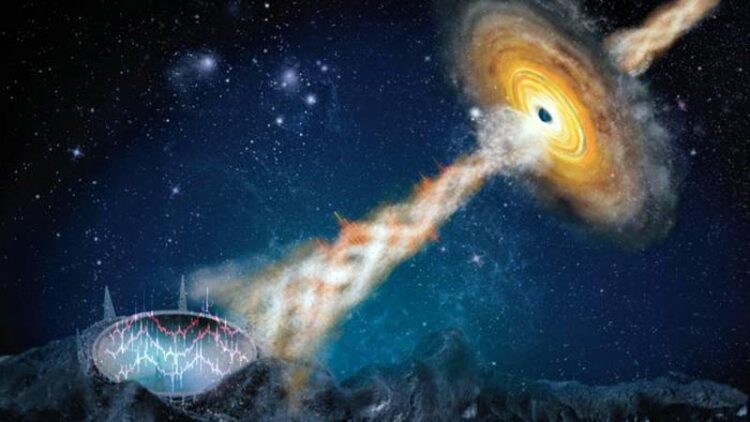Astronomers reveal new features of galactic black holes

Artist's depiction of microquasar event captured by FAST Telescope.
Courtesy Professor Wei Wang, Wuhan University
International team of scientists reports in Nature the first detection of a quasi-periodic oscillation signal in the radio band from a Galactic black hole system.
Black holes are the most mysterious objects in the universe, with features that sound like they come straight from a sci-fi movie.
Stellar-mass black holes with masses of roughly 10 suns, for example, reveal their existence by eating materials from their companion stars. And in some instances, supermassive black holes accumulate at the center of some galaxies to form bright compact regions known as quasars with masses equal to millions to billions of our sun. A subset of accreting stellar-mass black holes that can launch jets of highly magnetized plasma are called microquasars.
An international team of scientists, including UNLV astrophysicist Bing Zhang, reports in the July 26 issue of Nature a dedicated observational campaign on the Galactic microquasar dubbed GRS 1915+105. The team revealed features of a microquasar system that have never before been seen.
Using the massive Five-hundred-meter Aperture Spherical radio Telescope (FAST) in China, astronomers discovered a quasi-periodic oscillation (QPO) signal in the radio band for the first time from any microquasar systems. QPOs are a phenomenon that astronomers use to understand how stellar systems like black holes function. And while they have been observed in X-rays from microquasars, their presence outside of this manner — as part of the system’s radio emission — is unique.
“The peculiar QPO signal has a rough period of 0.2 seconds, or a frequency of about 5 Hertz,” said Wei Wang, a professor with China’s Wuhan University who led the team that made the discovery. “Such a signal does not always exist and only shows up under special physical conditions. Our team was lucky enough to catch the signal twice — in January 2021 and June 2022, respectively.”
According to UNLV’s Zhang, director of the Nevada Center for Astrophysics and one of the study’s corresponding authors, this unique feature may provide the first evidence of activity from a “jet” launched by a Galactic stellar-mass black hole. Under certain conditions, some black hole binary systems launch a jet — a mix of parallel beams of charged matter and a magnetic field that moves with a swiftness approaching the speed of light.
“In accreting black hole systems, X-rays usually probe the accretion disk around the black hole while radio emission usually probes the jet launched from the disk and the black hole,” said Zhang. “The detailed mechanism to induce temporal modulation in a relativistic jet is not identified, but one plausible mechanism would be that the jet is underlying precession, which means the jet direction is regularly pointing towards different directions and returns to the original direction once every about 0.2 seconds.”
Zhang said that a misalignment between the spin axis of the black hole and its accretion disk (extremely hot, bright spinning gasses surrounding the black hole) could cause this effect, which is a natural consequence of a dragging of spacetime near a rapidly spinning black hole.
“Other possibilities exist, though, and continued observations of this and other Galactic microquasar sources will bring more clues to understand these mysterious QPO signals,” said Zhang.
Publication Details
The study, “Sub-second periodic radio oscillation in a microquasar”, appeared July 26 in the journal Nature. The publication includes 21 co-authors from 13 institutions. Besides UNLV and Wuhan University, other institutions include National Astronomical Observatories of China (NAOC) and several other observatories and universities from China.
Journal: Nature
DOI: 10.1038/s41586-023-06336-6
Method of Research: Observational study
Subject of Research: Not applicable
Article Title: Subsecond periodic radio oscillations in a microquasar
Article Publication Date: 26-Jul-2023
Media Contact
Tony Allen
University of Nevada, Las Vegas
tony.allen@unlv.edu
Office: 702-895-0893
All latest news from the category: Physics and Astronomy
This area deals with the fundamental laws and building blocks of nature and how they interact, the properties and the behavior of matter, and research into space and time and their structures.
innovations-report provides in-depth reports and articles on subjects such as astrophysics, laser technologies, nuclear, quantum, particle and solid-state physics, nanotechnologies, planetary research and findings (Mars, Venus) and developments related to the Hubble Telescope.
Newest articles

Webb captures top of iconic horsehead nebula in unprecedented detail
NASA’s James Webb Space Telescope has captured the sharpest infrared images to date of a zoomed-in portion of one of the most distinctive objects in our skies, the Horsehead Nebula….

Cost-effective, high-capacity, and cyclable lithium-ion battery cathodes
Charge-recharge cycling of lithium-superrich iron oxide, a cost-effective and high-capacity cathode for new-generation lithium-ion batteries, can be greatly improved by doping with readily available mineral elements. The energy capacity and…

Novel genetic plant regeneration approach
…without the application of phytohormones. Researchers develop a novel plant regeneration approach by modulating the expression of genes that control plant cell differentiation. For ages now, plants have been the…





















